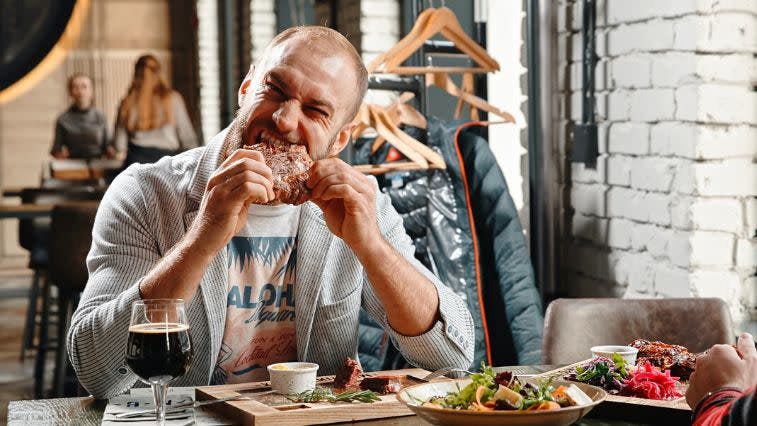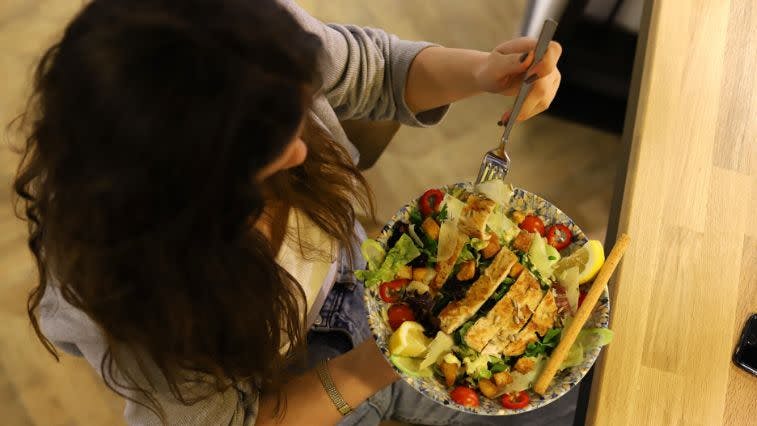How to Lose Fat and Gain Muscle: It Starts With Diet
Our content strives to support, inform, and motivate you to meet your health goals. We want to be your trusted source of expert- and science-backed info dispensed in simple, actionable ways. Read our Editorial Guidelines.
Losing fat while building muscle isn’t a pipe dream. This guide will teach you how to do this with some super simple diet tweaks.
A few of these tweaks include maintaining a small calorie deficit, prioritizing protein, and drinking plenty of water. With a focused fat-burning diet, a strategic exercise plan, and accountability, you’ll meet your body recomposition goals in no time.
But what does body recomposition mean, and how can you build muscle and lose fat at the same time?
As a registered dietitian and weight loss expert, I’ll share the exact nutrition strategies my clients use to build muscle and lose fat without using extreme methods, hours at the gym, or deprivation.
What Is Body Recomposition?
Body recomposition is an approach to weight loss that focuses on altering your body composition. Your body is comprised of fat, muscle, bone, and water in varying percentages. We need all of these for optimal health, but altering the composition in a way where you have less fat and more muscle will benefit your physical and mental health.
Many times with weight loss the goal is to lose fat, but if you’re not careful you may end up losing muscle in your pursuit. Muscle loss can slow down your metabolism over time, making it harder to maintain weight loss long-term.
I’ve seen this with many of my clients who have followed very strict diets in the past. They may lose weight very quickly because they’re on a very low-calorie diet, but they lose muscle along with it.
And if you’ve ever lost weight but also lost muscle in the process, you may not have been happy with how you looked. If you want to lose some body fat but maintain a toned physique, you’ll want to eat in a way that supports muscle gain.
The food choices you make (or don’t make) can help you lose fat and maintain lean muscle. The best way to do this involves eating in a way to build muscle while also staying in a calorie deficit that supports fat loss.
Nutrition Strategies to Gain Muscle and Lose Fat
Here are eight key nutrition habits to help you build muscle and lose fat at the same time.
1. Stay in a calorie deficit
A calorie deficit is necessary to lose weight and burn fat. But the amount of calories you cut out is a fine line, meaning you don’t want to be too strict.
A good rule of thumb is to determine your daily baseline calories to maintain your weight, then subtract 500 calories from that to get your calories for weight loss.
2. Prioritize protein

It’s not just how much you’re eating, but what you’re eating that matters. When you’re in a calorie deficit, your body will naturally gravitate towards breaking down both fat and muscle if you don’t eat enough protein to keep up with that demand.
Keep your muscle stores up by prioritizing protein sources in your diet. The recommendation is to get in at least 1.2–2.0 grams of protein per kilogram of body weight. For a 150-pound person, this would be around 81–137 grams of protein per day.
These are the best protein sources:
Lean chicken breast, fish, turkey, pork tenderloin
Soy-based protein like tofu or seitan
Eggs
Beans, lentils, edamame
Low-fat or fat-free dairy: milk, cheese, plain Greek yogurt, plain cottage cheese
Nuts and seeds
Nut butter
Individual protein needs can vary based on your activity level, goals, and medical history, so always consult with an expert to determine the best amount for your needs.
3. Eat whole foods
It’s not just about cutting calories and meeting your macros — you still need to make good food choices. If you’re on a 1400-calorie diet but most of your calories come from processed snacks like pretzels or chips, you probably won’t see the results you’re looking for.
Shop the perimeter of the grocery store for the majority of your food. Think fruits, veggies, lean proteins, and low-fat dairy as your staples. These foods are in their natural form, highly nutritious, and minimally processed, making them easier to break down and convert into sustainable energy. Because of this, they’re also more satisfying. Getting more of your calories from these whole foods will make it easier to stay in a calorie deficit.
4. Consider intermittent fasting
Intermittent fasting (IF) has many potential benefits, but it has also been shown to preserve lean muscle mass. Studies have shown those who practice intermittent fasting along with resistance training lose fat, but also maintain muscle.
There are many approaches to practicing intermittent fasting, and we recommend a gradual approach to start. You can also learn more about how to determine if intermittent fasting is for you in this blog post.
5. Refuel after a workout
Are you refueling after your workouts, or are you just going about your day afterward?
I’ve made the mistake of skipping refueling before, and it definitely leads to longer recovery time and more fatigue.
After working out, your body is in a depleted state and will break down muscle protein for energy if you don’t refuel with needed nutrients.
It’s important to keep in mind that what you eat after a workout may vary depending on the intensity of your workout. For example, you will need more replenishment after a long run compared to a lower-intensity yoga flow.
For workouts longer than one hour, refueling with some good old low-fat milk, hard-boiled eggs, or unsweetened Greek yogurt post-workout can replenish those nutrients you lost.
For lower-intensity or shorter workouts, refueling with water and a small handful of nuts may be all you need.
Refueling properly helps you rebuild muscle tissue that was broken down during your workout, supporting your muscle gain goals.
6. Avoid ultra-processed foods
Ultra-processed foods are essentially any foods that are not in their original form. It’s not always a bad thing, but there are a few that you’ll want to keep away from as much as possible.
Some examples are:
Bagged snacks: potato chips, pretzels, Cheetos
Cookies, candy, cake
Baked goods like muffins, donuts, danishes
Refined carbs like bagels, English muffins, white bread
All of these foods are high in sugar or salt, but low in nutrients. They’re broken down in your body very quickly and don’t keep you full for long. Eating them can lead to overeating and weight gain, and they don’t provide any real nutritional value to be considered a source of fuel.
You can absolutely enjoy them as an occasional treat, but they shouldn’t be an everyday occurrence.
7. Reduce sugary drinks
Sweetened beverages like sweet coffees, soda, juice, or energy drinks are loaded with added sugar. Replacing these drinks with some refreshing H20 as much as possible will help you slash your sugar intake and burn fat more efficiently.
If you aren’t a plain water fan, you can add lemon, lime, or — my favorite — cucumber and mint to your water to flavor it. If you’re used to drinking a lot of sugary drinks, you’ll be amazed at the difference it makes in your calorie intake (and in how you feel) when you cut back on it.
8. Up your fiber

While eating doesn’t directly build muscle, fiber helps support fat loss at every angle. High-fiber foods are incredibly satisfying, helping you eat less naturally. With these qualities, it can feel easier to stay in a calorie deficit.
Include at least one of these high-fiber foods with every meal:
Fruits and veggies
Beans, lentils, edamame
Whole grains: oats, quinoa, bulgur, brown rice
Seeds: chia, flax, hemp
If you’re currently not eating a lot of fiber, it’s best to add it to your diet gradually to prevent any bloating or digestive discomfort.
The Bottom Line
You can build muscle and lose fat at the same time with some simple diet changes such as incorporating more whole foods, upping your protein and fiber, and limiting processed and sugary foods and drinks.
When it comes to meeting your body composition goals, everyone has their own individual needs, preferences, and lifestyle. Getting support, accountability, and personalized guidance from an expert coach can help you meet your goals faster and in a way that works for you.
Take our quiz today to receive your free personal trainer consultation and get the support you need to take control of your health.